Ahsan A. (ed.) Evaporation, Condensation and Heat transfer
Подождите немного. Документ загружается.

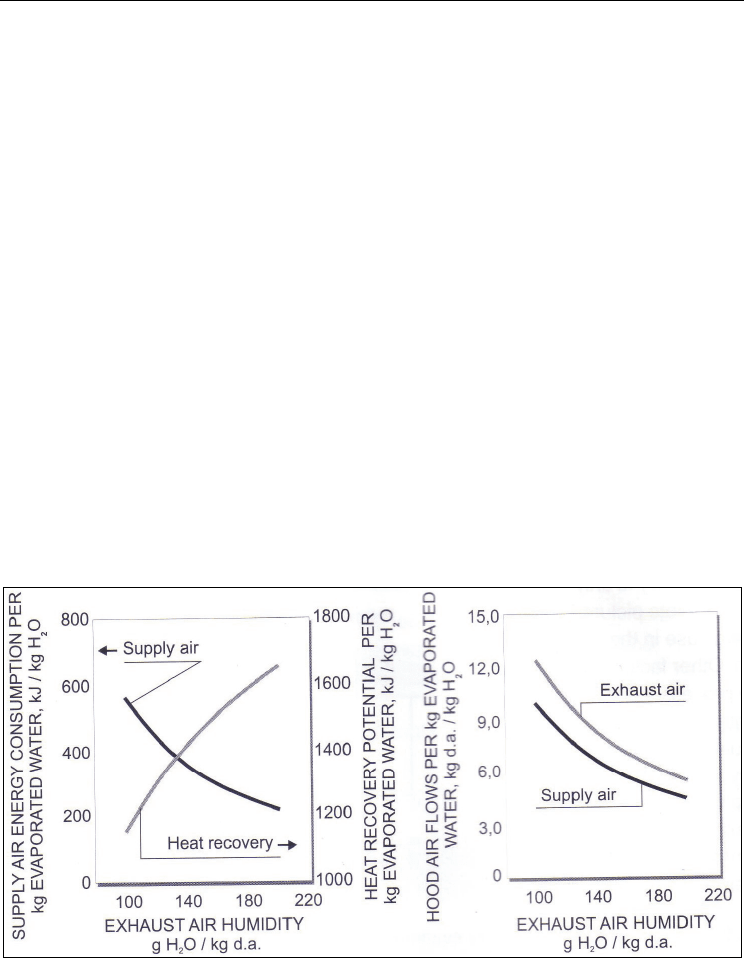
Fundamentals of Paper Drying – Theory and Application from Industrial Perspective
559
efficiency. Moreover, evaporation rates differ depending on paper grade and production
volume. A hood balance should be carried out for the production volume requiring the
highest evaporation rates in the dryers.
Depending upon the type of hood present in an existing paper machine dryer section, the
optimal amounts of total ‘supply’ and exhaust air required per unit mass of water
evaporated will vary. The required hood balance (defined as the ratio of total ‘supply’ to
total exhaust air) is largely influenced by the hood type i.e., whether the hood is an open,
conventional closed or high-humidity closed hood. The hood balance for a modern paper
machine with a closed hood should be close to 0.8, while that for an older machine with
open hood should be between 0.3 and 0.4. If the hood balance is too high then this results in
spillage from the hood into the machine room. A low balance results in sweating,
runnability problems and poor profile in the cross direction (CD). Conditions around the
machine may become uncomfortable and troubleshooting, broke cleaning and operations
may become difficult. In many machines, an actual hood balance is rarely carried out. The
importance of air balance is often ignored potentially losing opportunity to improve drying
efficiency (Sundqvist, 1996; Ghosh, 2005).
6.2.2 Supply and exhaust airflows
The optimal amounts of total ‘supply’ and exhaust air required per unit mass of water
evaporated will vary depending upon the type of hood present in an existing paper machine
dryer section. Fully Closed high humidity hood of modern paper machines can operate at
absolute humidity level of up to 0.18 g water/g dry air. Maintaining hood at higher humid
condition can have significant benefits: requirement of lower supply and exhaust airflows
and higher potential of heat recovery from the dryer exhaust as shown in Figure 6.5
(Sundqvist, 1995). Lower supply air will require less steam consumption motor power.
Fig. 6.5 Influence of exhaust air humidity on energy consumption and airflows of the hood
Table 6.1 shows the typical parameters recommended for different type of hood. Pocket
ventilation air required for high humidity hood is significantly lower, 6-7 kg/kg water
evaporated compared to open hood system that require 20-30 kg/kg water evaporated. For
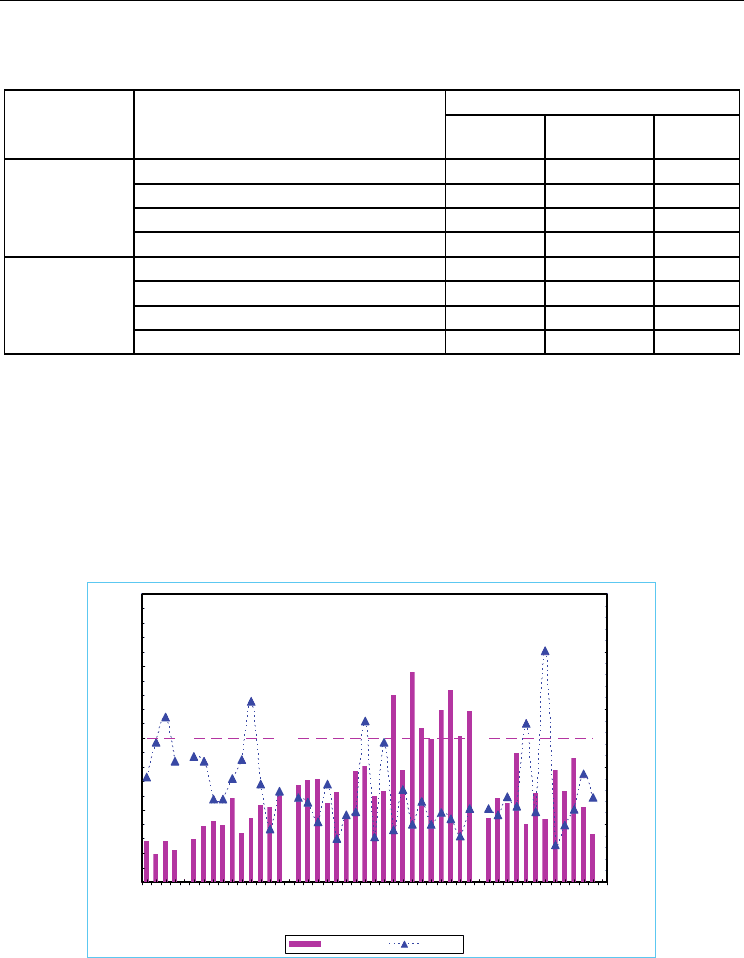
Evaporation, Condensation and Heat Transfer
560
high humidity hood, the basement of the paper machine is also fully enclosed
(Panchapakesan, 1991).
Hood Type
Air Stream
Conditions
OPEN MEDIUM HIGH
Humidity Range, g water/g dry air 0.01-0.012 0.01 0.012
Temperature after heat recovery,
o
C 30-40 55-6590-100 60-65
Temperature into Hood,
o
C 40-60 90-100 90-100
Supply
Mass Flow, % of Exhaust 30-50 50-70 70-80
Humidity Range, g H
2
O/g dry air 0.04 - 0.07 0.12 - 0.14 0.16-0.18
Temperature,
o
C 50-60 80-90 80-90
Dew Point Temperature,
o
C 37-46 53-57 61-63
Exhaust
Mass Flow, kg air/kg evaporated 20-30 9-12 6-7
Table 6.1 Typical parameters for different hood types
6.2.3 Supply air distribution and pocket humidity
It is important to note that proper ventilation of dryer pockets not only required sufficient
amount of ventilation but also proper distribution of such air is critical in achieving the
optimal benefits of a fully closed hood. Air movement/flow inside the pocket is critical in
maintaining dryer pockets reasonably dry and prevents from sweating. Pockets with higher
air flow also exhibit lower humidity. This is evident from the measured humidity and air
flow inside pockets of a newsprint machine as shown in Figure 6.6.
0.00
0.10
0.20
0.30
0.40
1
2
3
4
Sec 1
5
6
7
8
9
10
11
12
13
14
Sec 2
15
16
17
18
19
20
21
22
23
24
25
26
27
28
29
30
31
32
33
Sec 3
34
35
36
37
38
39
40
41
42
43
44
45
Sec 4
DRYER POCKET NUMBER
Abs. Humidity, g ater/ g Ai
r
0.0
0.5
1.0
1.5
2.0
2.5
Air Flow, m/s
Abs. Humidity Air Flow
Fig. 6.6 Superimposition of air flow and humidity inside dryer pockets
Many modern machines with high humidity hoods are equipped with variable speed
motors for both supply and exhaust air. Installation of temperature, humidity and pressure

Fundamentals of Paper Drying – Theory and Application from Industrial Perspective
561
sensor/transducer on the exhaust can provide operators tool to control the conditions of
exhaust air in maintaining high humid conditions within the dryer pockets to conserve
drying energy and improved machine runnability.
6.3 Dryer fabric and ventilation
Air handling is an important task for a dryer fabric in a high speed machine. The
aerodynamic features of the fabric structures, openness of the fabric, geometry of the dryer
pockets and machine determine the air pumping and dragging effect of the fabric. Dryer
fabric permeability plays an important role in pocket ventilation and runnability. The dryer
fabric is required to perform many functions in the dryer section. It must be mechanically
stable as it acts as a drive belt. It must avoid breakdown due to its operating environment
and its surface properties must not adversely affect the paper. It must also provide a
uniform pressure distribution to maximize heat transfer. The fabric also has a very
important function in controlling air movement both in and outside the dryer pocket. The
main characteristics which affect these air flows are dryer fabric permeability, aerodynamic
properties and the dryer fabrics ability to control air at ingoing nips.
6.3.1 Fabric permeability
The permeability of the dryer fabric is a function of the weave pattern, the yarn sizes and
shapes and the density of the yarns in both the machine and cross direction. Conventional
practice with the selection of dryer fabric permeability is that the permeability increases
following the dryer curve of the machine. That is during the pre heating stage, where the
sheet is most wet and requiring maximum support, a dense smooth fabric is required.
Consequently this fabric is generally the lowest in permeability.
As the sheet then heats and water evaporation intensifies, the removal of water vapour and
steam increases in volume and therefore in order for this to escape, a higher permeable
fabric is required. Therefore the air permeability of the fabric has a major impact upon the
flow of evaporated water from the heated sheet into the pocket. Any blockages of these
paths will result in this flow reducing and possibly being blocked. This will subsequently
reduce the overall drying efficiency of this section. As this sheet has not then reached its
optimal dryness the next section will be required to remove the remaining moisture. If this
section already has inadequate drying efficiency then the problems becomes compounded.
The paper maker may have no alternative but to reduce the speed of the machine.
There are limitations on the range of permeability available per drying section. For example
in the later sections care must be taken not to have too high permeability as otherwise the
sheet may become unstable. For a typical paper machine permeability ranges are 75 to 110
ft
3
/min in pre heating, single tier and uno runs, 110 to 250 ft
3
/min for conventional top and
bottom and single tier drying sections and finally 250 to 700 ft
3
/min for final drying
sections.
Another of the impacts of dryer fabric permeability is the effect upon systems such as
vacuum rolls and blow boxes. These elements are designed to assist with both air and sheet
management. Again incorrect selection of fabric permeability may result in the inefficient
function of these elements. This may subsequently force the paper maker to make machine
adjustments such as increased draws or even reduced overall machine speed.
6.3.2 Aerodynamic properties
The second most important characteristic of a dryer fabric which can adversely affect dryer
pocket ventilation is its aerodynamic properties (Joseph, 1988). There are two key issues in
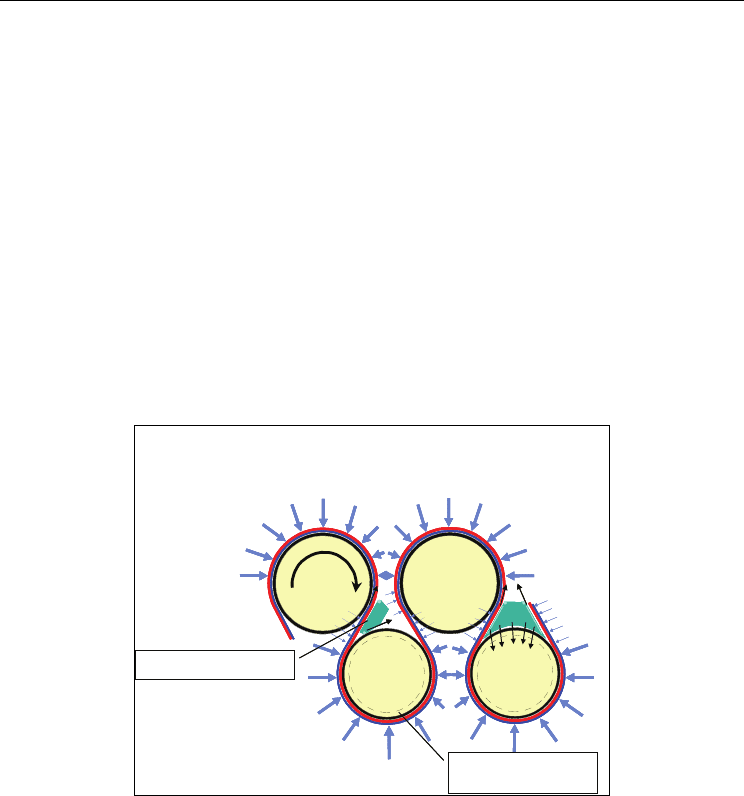
Evaporation, Condensation and Heat Transfer
562
relationship to the aerodynamic properties. The first issue is the fabrics affect upon the
boundary air layer, the layer of air immediately above the surface of the fabric. In a fabric
with a high co-efficient of drag, the fabric will cause the air layer to be disturbed and
ultimately cause that layer to flow with the surface. The outcome of this behaviour therefore
is that as the paper and fabric converge onto a roll or cylinder, the air between these moving
elements becomes trapped and compressed. This compressed air, if unable to be evacuated,
results in the formation of areas of trapped air which consequently can force the sheet to
leave the surface of the fabric or in the case of open draws, for the sheet to ‘flutter’
uncontrollably.
As machine speeds have increased sheet control issues have been exacerbated.
Consequently machine builders have developed ways to mechanically minimize problems
related to the movement of air in pockets. The most common of these elements are anti blow
boxes and vacuum rolls on single tier sections as shown in Figure 6.7.
The function of
vacuum cylinders and anti-blow boxes is to minimize the build up of compressed air. As
previously mentioned the permeability of the fabric can affect the efficiency of these
elements, especially if the fabric becomes contaminated. The blocking of the voids in the
fabric will result in no vacuum being applied through the fabric to the paper sheet (Luc,
2004).
Single Tier Dryer Section
Vacuum Rolls
Anti- blow boxes
Single Tier Dryer Section
Vacuum Rolls
Anti- blow boxes
Fig. 6.7 Anti-blow box & vacuum rolls in a single-tier dryer
The way to reduce the flow of boundary air with the dryer fabric is to reduce the co-efficient
of drag (COD). As with any aerodynamic surface the principle approach to reducing COD is
to minimize variations in the physical surface. With a dryer fabric this means that the fabric
is designed to have as planar a surface as possible. This is typically achieved through the use
of specific weave patterns and flat yarn materials.
6.4 Heat recovery
Significant amounts of heat energy supplied to the dryer section through the steam in the
cylinder and hot supply air ends up in the dryer exhaust stream. In closed hood system, the
temperature of exhaust air could be as high as 85
o
C. For economic reason, some of this heat
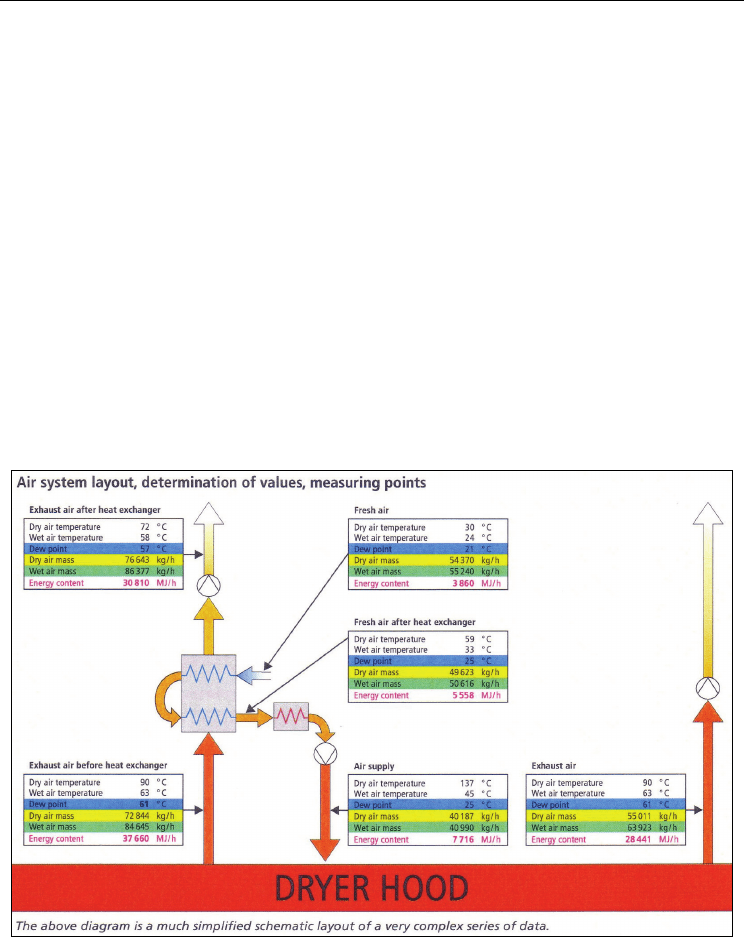
Fundamentals of Paper Drying – Theory and Application from Industrial Perspective
563
is recovered and re-used in the drying process. This is particularly true for countries in the
northern hemisphere when outside temperature in winter period could be very low.
Increasing cost of energy also make it attractive to recover heat from the exhaust stream.
Figure 6.8 shows the schematic of a first stage heat recovery. In this schematic, fresh air is
heated by use of heat exchanger, where heat from dryer exhaust air is recovered. Water and
heat balance is shown here. Basically four types of heat exchangers are used in dryer section
heat recovery systems. Usually, a heat recovery system will use more than one type of
exchanger to perform the desired tasks.
In
air/air type of heat exchanger, hot and humid exhaust air heats an air flow such as dyer
section supply air, or machine room ventilation air. The heat transfer occur s through a heat
surface, and no contact occurs between the two flows. In air/water heat exchanger, hot and
humid exhaust air heats a water flow that can be fresh water, white water or a glycol and
water mixture used as circulation water in the machine room ventilation air heating system.
Also, in this case, heat transfer occurs through a heated surface. In
scrubber, exhaust air and
the water to be heated by direct contact with each other. The scrubber consists of a series of
nozzles whose number depends on the amount of water to be heated. The fourth type of
heat exchanger is simple
air coils. Air coil units are used for transferring heat from a water
flow to an air flow. A typical application is heating of machine room ventilation air with a
circulating water and glycol mixture.
Fig. 6.8 Heat recovery systems from dryer hood exhaust
For a modern linerboard machine producing 450,000 ton per year, the amount of heat
energy associated with the exhaust air is shown in Table 6.2. The temperature of the exhaust
air in four exhaust outlets vary between 74 and 85
o
C and this temperature is quite high and
suitable for efficient heat recovery.
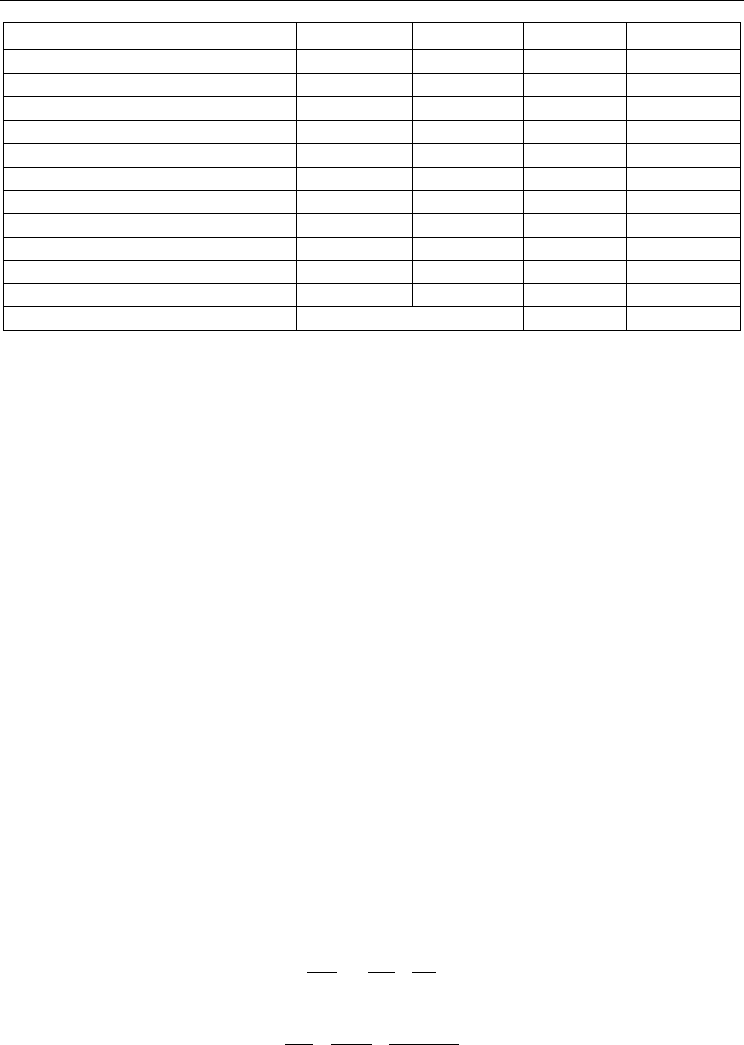
Evaporation, Condensation and Heat Transfer
564
Exhaust A Exhaust B Exhaust C Exhaust D
Temperature,
o
C 74 77 81 85
Relative Humidity, % 34.1 29.0 26.0 24.0
Duct Area, m
2
0.636 2.466 2.466 2.466
Average Velocity, m/s 22.80 25.80 31.80 31
Dew Point Temperature,
o
C 50.3 49.7 50.7 52.0
Absolute Humidity, g w/g air 0.087 0.084 0.088 0.095
Heat Content, kJ/kg 308.2 304.8 320.5 341.6
Air Mass Flow, ton/hr 46.61 203.4 246.4 235.6
Water Mass Flow, ton/hr 4.04 17.08 21.81 22.42
Volumetric Flow, m
3
/hr 4528 19234 24980 26191
Heat Flow, MJ/hr 14365 61994 78986 80486
Total Heat OUT, MJ/hr 235831.0
Table 6.2 Actual amounts of Heat energy in dryer exhaust for a Linerboard Machine
7. Use of computer model or simulation in optimizing drying efficiency
A number of models of paper drying have been developed by academics and paper machine
manufacturers [Karlson et al., 1995; Bond et al., 1996; Iida, 1985]. However, such models are
not always easily available to paper manufacturers. A dryer simulation program developed
earlier by the author (Ghosh, 1988) has been used
to simulate the moisture and temperature
profiles of the web in the middle of free run after each cylinder, as the paper web traveled
towards the reel, using the operating conditions of the machine, the pocket and the surface
conditions of the dryer cylinders measured during the audit. Measurement of web moisture
after each dryer cylinder is very difficult, if not impossible, without breaking the web.
Generally only moisture data that are available are after the last press (or at the entrance of
the first dryer can) and at the end of the paper machine. In some machines, moisture
scanners are located before the size press. Moisture values could be obtained from
simulation based on dryer model. Like any other computer model, the usefulness of such
tool largely depends upon reliable and practical input data. Such model used real world
data obtained from field measurements during systematic audits of the dryer section. The
simulated web moisture data were subsequently used to calculate the drying rate and
driving force for evaporation of each cylinder. The model has also been used to explore
various ‘what-if’ scenario that could lead to highlight the potential for improvement or
energy saving and are often requested by the mill. Model or simulation by itself does not
optimize/improve efficiency. It could be used as a tool to supplement system analysis and
when used in conjunction with audit and system analysis could be very useful.
The rate of change of moisture and heat content of paper can be expressed by the following
equations:
dM dV dL
dt db db
=− −
(20)
()
f
L
dH
dH d MH
dt dt dt
=+
(21)

Fundamentals of Paper Drying – Theory and Application from Industrial Perspective
565
()
Q
dT
QF
db
=−
(22)
()
V
V
dC
VF
db
=−
(23)
()
L
dM
LF
db
=−
(24)
Where
dM
dt
=Rate of change of moisture content in paper
dH
dt
=Rate of change of heat content of paper
V = vapour flux
L = liquid flux
Q = heat transfer coefficient
C
V
= water vapour concentration
H
V
, H
L
, H
f
= heat content of vapour, liquid and dry fibre
F
Q
, F
V
, F
L
= heat, vapour and liquid transfer coefficient = f(M)
M = gm water/gm fibre
b = basis weight, g/m
2
T = sheet temperature
The equation (20) and (21) can be solved by finite difference method. Web length in Machine
Direction (MD) is divided into finite lengths (difference). Heat and mass transfer fluxes is
calculated using web conditions at a certain location. This gives web condition at the
neighboring location determined by the differential equations. This step is repeated from the
beginning to the end of the dryer section
In any model and simulation, the output of such model is always dependent on accurate
and practical input of process data. When used in conjunction with audit and system
analysis, dryer simulation model could be very useful. The model can be used to explore
various ‘what-if’ scenarios such as changes in:
•
machine speed, basis weight
•
moisture, temperature of web to 1st dryer
•
steam pressure in any/whole section
•
dryer cylinder surface temperature
•
pocket conditions
•
size press operation
•
reel/size press (if size press is present and operational) moisture
Model only gives temperature and moisture of the sheet at one location in the machine
direction. Profile in cross direction is difficult to predict. Prediction of web moisture is
useful, as it is difficult to measure on a running web, the speed of which can be as high as
2000 m/min, depending upon the machine design and paper grades made. Drying rate
for each cylinder can also be calculated from the simulated moisture and the drying rates
thus calculated can be very useful in identifying heat transfer problem with specific
cylinder.

Evaporation, Condensation and Heat Transfer
566
Figure 7.1 shows the web moisture and drying rate after each dryer cylinder using the
simulation model that used ‘real world’ audit data for a newsprint machine. Similar results
for vapour pressure of each pocket and driving force to evaporate/remove water are shown
in Figure 7.2. The measured absolute humidity values of each pocket are also shown. It is
evident from these figures that level of absolute humidity of dryer pockets significantly
influences water evaporation. For pockets with very high humidity, evaporation is very
poor and reverse is the true for less humid pockets.
0
10
20
30
40
50
60
1 3 5 7 9 11131517192123252729 3133353739414345
Drye r Cylinder
W e b M oisture , %
40
60
80
100
Dryness, %
Moisture Dryness
0
5
10
15
20
25
30
1 3 5 7 9 11 13 15 17 19 21 23 25 27 29 31 33 35 37 39 41 43 45
Dryer Cylinder
Drying Rate, kg Water/hr/m
2
Fig. 7.1 Simulated web moisture and drying rate after each dryer cylinder
0
5
10
15
20
25
30
35
1 3 5 7 9 111315171921232527293133353739414345
Dryer Cylinder/Pocket
Vapour Pressure, kPa
0.0
0.1
0.2
0.3
0.4
Abs. Hum idity, g W/g Ai
r
Vapo ur P ressure Absolute Humidity
0
5
10
15
20
25
30
1 3 5 7 9 11 13 15 17 19 21 23 25 27 29 31 33 35 37 39 41 43 45
Dryer Cylinder/Pocket
Driving Force
0.0
0.1
0.2
0.3
0.4
Abs. Humidity, g W/g Air
Driving Fo rce Absolute Humidity
Fig. 7.2 Pocket Vapour pressure/driving force and absolute humidity
8. Performance of dryer section
One of the main objectives of any dryer audit/survey of a paper machine is to establish the
thermal performance (efficiency) of the machine at the existing operating conditions and
identify any scope of improvements.
8.1 Current performance or benchmarking
Before any improvement or optimization of the dry-end efficiency can be accomplished, the
current performance of the dryer section of a paper machine must be established first. The
most critical step in performance analysis is to obtain a proper set of field test measurements

Fundamentals of Paper Drying – Theory and Application from Industrial Perspective
567
and observations. All equipment information and sizes must be checked in the field and
compared with the flow schematics of the system. Field testing is generally carried out to:
•
establish machine operating conditions, speeds and sheet moisture.
•
establish drying curves.
•
measure energy consumption.
•
determine the operating problems and procedures through detailed discussions with
the operators.
•
obtain physical data for the system analysis.
•
assess the physical condition of the equipment.
•
establish key performance indicators.
•
compare the performance indicators of the machine with similar top performing
machines making the same grades.
Systematic measurement of the steam and condensate system, the pocket ventilation system
and the hood balance around the dryer section is a pre-requisite in optimizing dryer
performance (Hill, 1997; Perrault, 1989). Once such measurements are carried out, proper
analysis of such data will quantify the present conditions/performance of the dryer section
of a paper machine, compare dry end efficiency of the machine with others in the industry
making similar grade, identify the scopes for improvement in drying efficiency and
subsequent energy saving. Field data can also be used for simulation model in quantifying
potential tangible benefits.
8.2 Field measurements for performance evaluation
Once this has been established further follow on work are required. The systematic
approach that can be used comprised the following steps:
•
Measurement of cylinder surface temperatures, pocket temperatures, pocket humidity
values, air movements in each pocket, web temperature after each dryer cylinder across
the full width of the machine/pocket;
•
Measurement of condensate flow from each separator and check the steam pressures of
each section including the blow-through steam;
•
Measurement of air conditions (flow, temperature, humidity) of supply and exhaust air;
•
Analysis of data, including overall water and energy balance over the entire dryer
section and over individual heat recovery system;
•
Exploration of various ‘what-if’ scenario through simulation model using measured
data to quantify potential tangible benefits that could be achieved if the problems
identified are fixed;
•
Repeat audit/surveys following corrective actions based on preceding audits.
8.3 Performance indices
Performance of the dryer section of a paper machine can be described by various means.
However, the commonly used dryer performance indicators are :
•
TAPPI (Technical Association Pulp and Paper Industry) drying rate (kg water
removed/hr/m
2
of surface area);
•
steam efficiency (kg steam used/kg of water evaporated);
•
production efficiency (kg steam used/kg of paper produced) and
•
energy efficiency (mega joule of energy required per ton of water removed).
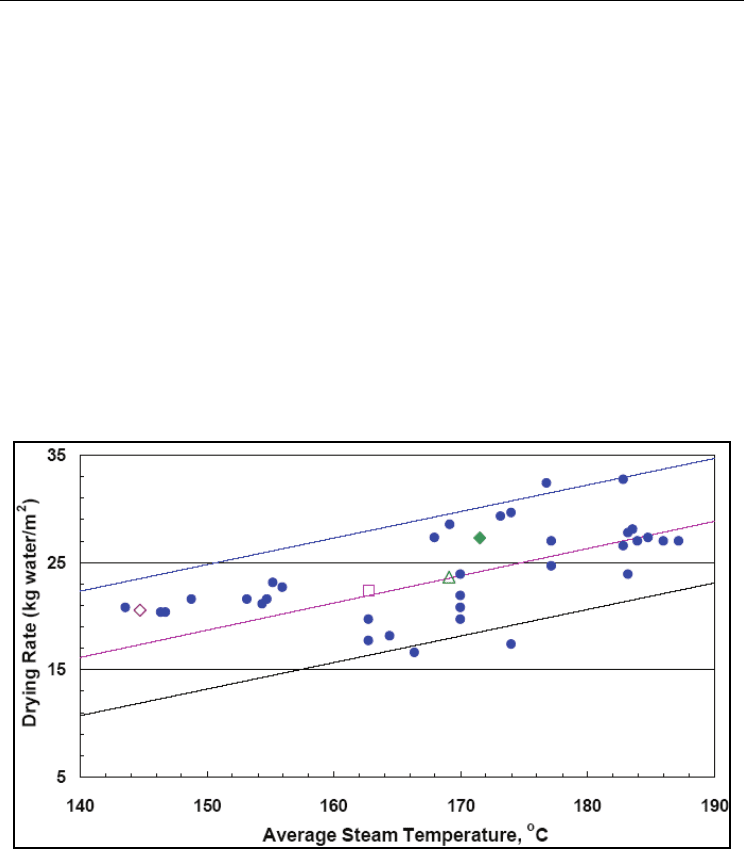
Evaporation, Condensation and Heat Transfer
568
The steam efficiency is the more rational performance indicator as it reflects the actual
amount of water evaporated irrespective of the performance of the press section of a paper
machine i.e., whether the dryness entering the dryer section is good or poor. However, from
financial view point the total amount of energy used per ton of paper produced is the most
important.
8.3.1 Drying rate
Depending upon the use of size press in the paper machine, the Tappi drying rate could be
categorized into three rates: overall, pre-dryer and after-dryer. If size press is absent or off, only
one drying rate (overall) is obtained. If a moisture spray is present to control the CD
moisture profile in the reeler, the amounts of extra water spray used should also be
included in the calculation of dry end efficiency of the machine.
TAPPI surveyed a large number of paper machines in North America producing similar
grade of products and published the drying rate for specific grades such as newsprint, liner
board, medium, fine paper etc as function of average dryer steam pressure. From the survey
data, TAPPI also recommended mean, upper and lower limits of drying rates for each
grade. Figure 8.1
shows the location of actually measured overall drying rates of several
machines producing linerboard products.
Fig. 8.1 Tappi Drying Rate for Machine A producing Linerboard products
The overall drying rate for Machine A based on the data was 27.3 kg H
2
O/hr/m
2
at 171.5
o
C
average steam temperature. This value is higher than the mean value of the TAPPI surveyed
machines, and is higher than the corresponding values obtained during previous audits,
suggesting improvement in drying rate. It is important to note that the calculation of drying
rate is significantly influenced on the web moisture entering the dryer section and also the
final web moisture at the reeler. Quite often, web moisture entering the dryer section is not
measured and use of mill supplied historical moisture value can affect the overall drying
rate.
